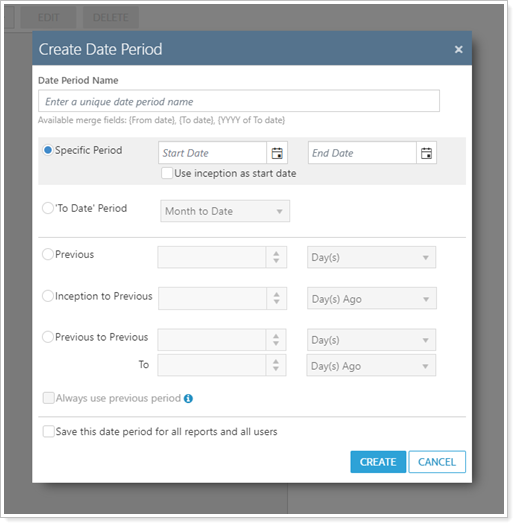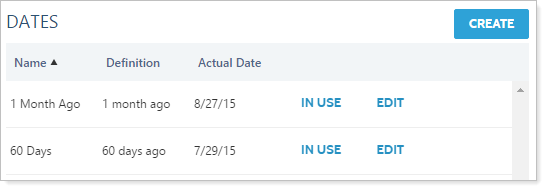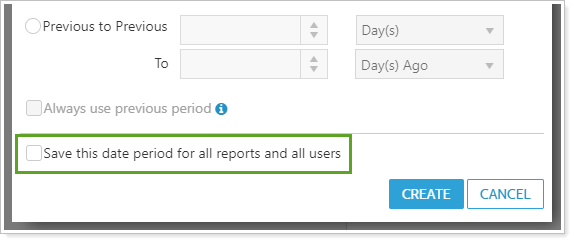 Back
Back
 Back Back |
Home > Tamarac Reporting > Saved Searches Benchmarks & Dates > Dates & Date Periods > Dates and Date Periods
|
Dates and Date Periods
|
Where You'll Find Dates and Date Periods in Tamarac |
Whenever you run a report, you report on a certain time range. For example, at the end of the quarter, you report on the previous quarter's results. When looking at holdings, you check a portfolio's holdings on a certain day. In Tamarac, you designate these using dates and date periods, depending on the type of report you're running. For more information, see Contents.
With dates and date periods, you can:
Save Useful Dates or Date Periods.Because you'll likely want to reuse certain dates or date periods, like the previous year-end or the previous quarter, Tamarac allows you to create and save as many dates or date periods as you need.
Share Commonly Used Dates or Date Periods.When you create a date or date period that could be useful across your firm, you can share it. Once you or someone else uses a date or date period in a report view, you won't be able to delete the date or date period.
Create On the Fly.Create date periods as you need them anywhere you see a date or date period list in dynamic reports, client views, and dashboard reports.
Keep One-Off Dates for Date Periods Temporarily.When you create a date or date period that you only need once—for example, a specific date like April 4, 2012—you can opt to only keep it temporarily. For more information, see Contents.
Reports and client communications in Tamarac are based on various dates and date periods. Once you create dates and date periods, you can apply them throughout Tamarac to keep reporting accurate and consistent.
You can set up dates and date periods in the following places:
Setup Menu.Create, edit, and delete dates and date periods and see definitions of each on the Setup menu under Firm Settings.

Reports Settings.Dates and date periods appear in nearly all dynamic and PDF reports. You can create new dates or date periods on the fly when you choose <Create New> in a report settings date or date period list, but you must go to the Dates or Date Periods page on the Setup menu to edit or delete them.

Dates and date periods differ in what they accomplish in reporting tasks:
Dates are a specific point in time.
Date periods are a range of time.
The following is more information on the difference and between these two concepts and how they're used.
You may want to define a specific date, such as the previous month end, quarter end, or a significant date not related to the ends of quarters, months, or years. Dates let you capture a single point of time across many dynamic and PDF reports. Many holdings reports use a date because they report on what an account holds at a specific point in time.
These are the types of dates you can set up:

For more information on creating dates, see Create, Edit, or Delete Dates.
Date periods represent a range of time. Many reports provide analysis and metrics that cover date ranges like the previous year or the current quarter. Date periods allow you to define and use that range of time across many dynamic and PDF reports. Date periods are common in transaction and performance reports to show what took place over a range of time.
The date period types are flexible and let you customize how you define ranges of time. These are the types of date periods you can set up:

For more information on creating date periods, see Create, Edit, or Delete Date Periods.
You can create temporary dates and date periods directly inside of some report settings. This is useful in situations where you want to troubleshoot issues or answer clients' questions.
When you know you won't want to use that range of time again, you can create a temporary date or date period for the report you're viewing. Temporary dates and date periods have these benefits:
Less clutter.They aren't saved when you log out or navigate away from a report, so they won't clutter your list of dates or date periods.
Report specific.They only appear on the report where you create them.
Smart deletion.They are not deleted while they're in use. If you're using one of them in a report view, that date or date period won't be deleted until you change the report view date settings.
Saveable.If you find a temporary date or date period that you want to use again, you can save it for others to use. For more information, see Save This Date For All Reports and All Users and Save This Date Period For All Reports and All Users.

For more information on using temporary dates or date periods, see Create, Edit, or Delete a Temporary Date or Date Period.